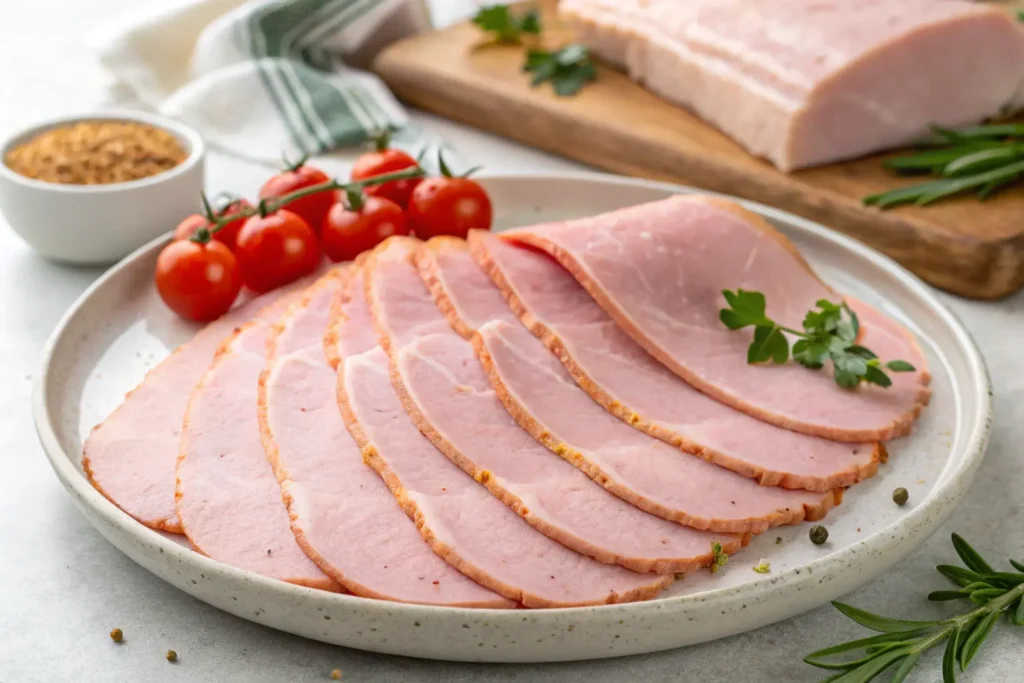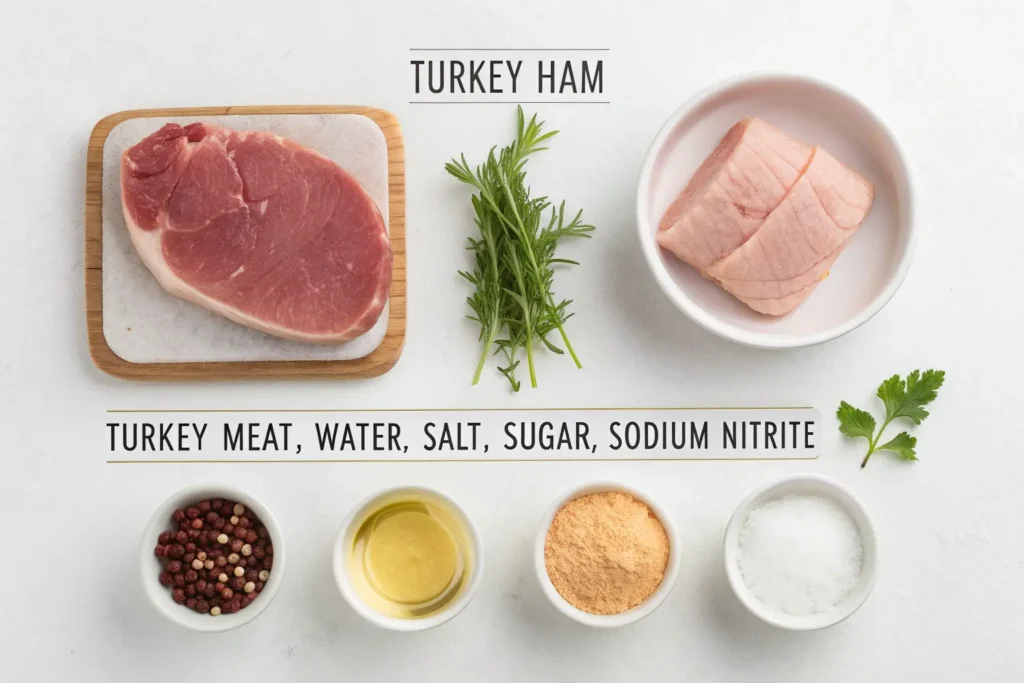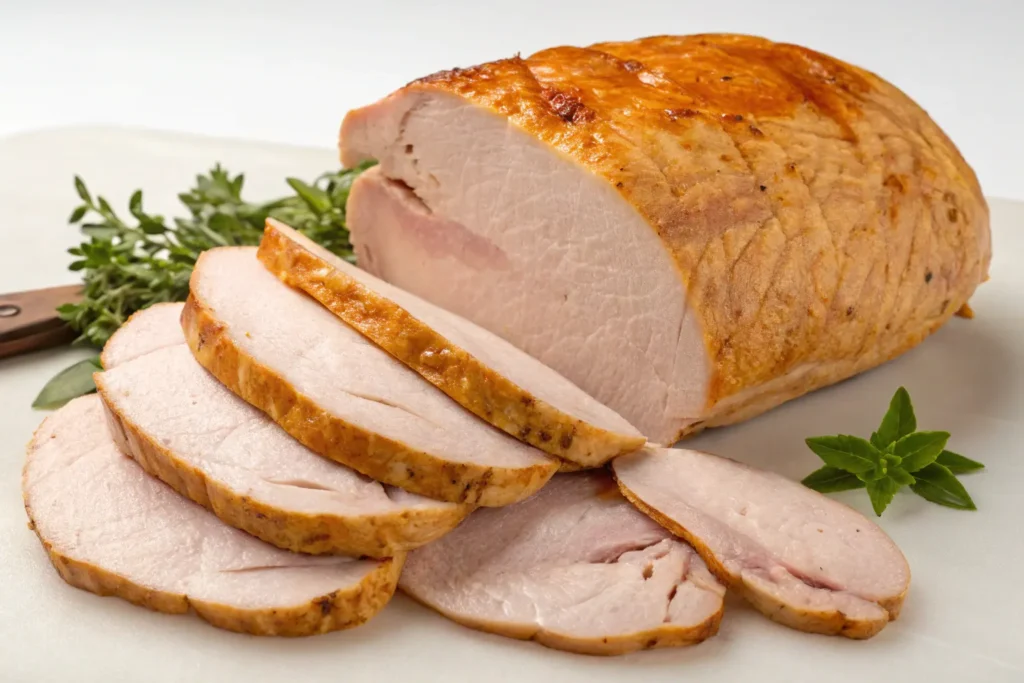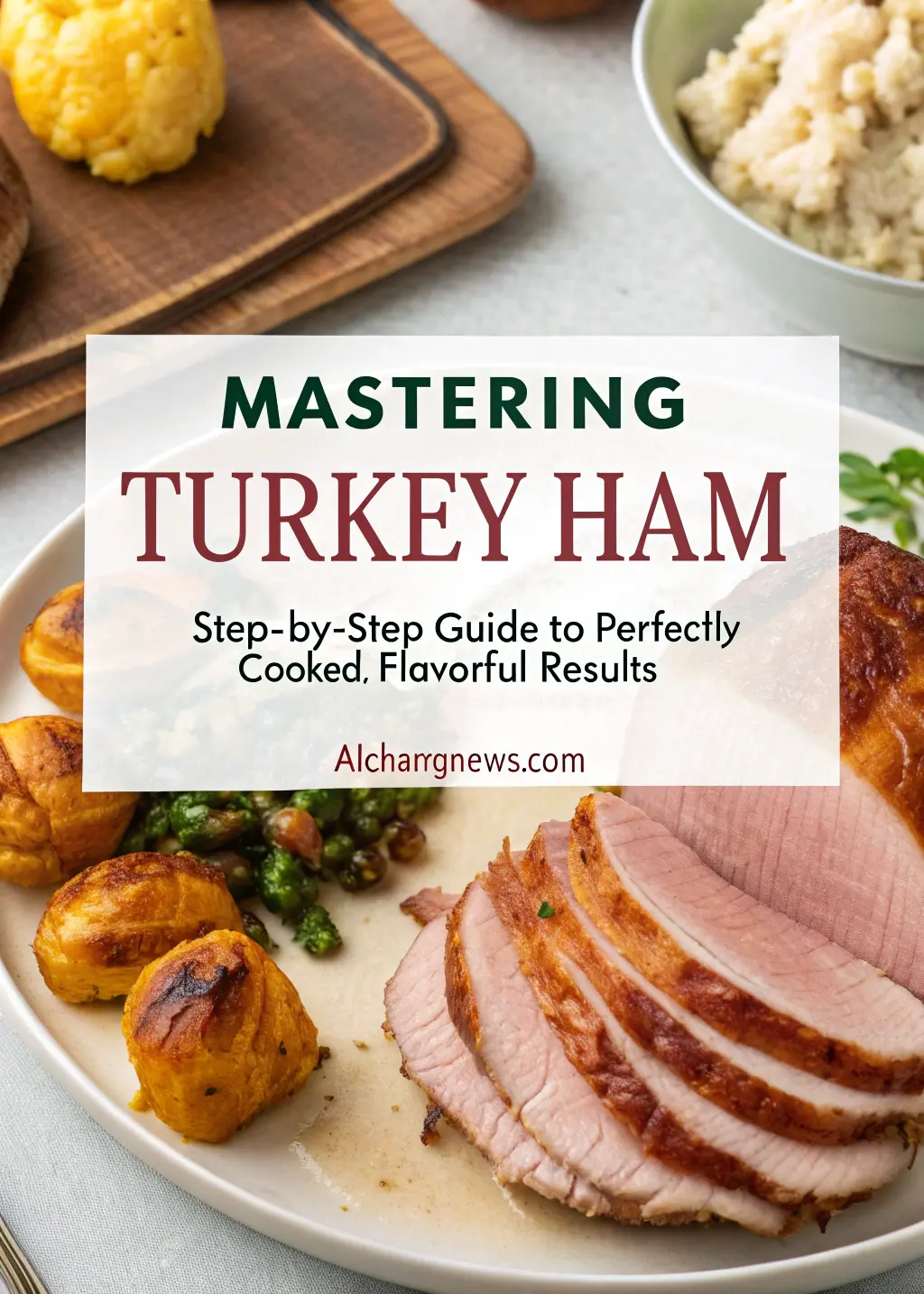There’s something profoundly satisfying about the aroma wafting through your kitchen as turkey ham slowly warms to perfection. That distinctive sweet-savory scent creates an atmosphere of anticipation that transforms an ordinary meal into something special. Perhaps it reminds you of childhood gatherings, where relatives huddled around the dining table sharing stories while savoring each tender, flavorful bite. These culinary memories connect us to our past while creating new traditions for the future.
Whether preparing a casual weekend meal or planning a holiday feast, turkey ham offers remarkable versatility and health benefits compared to its pork counterpart. While often overlooked in favor of more traditional options, this delightful alternative rewards those willing to master its preparation with succulent texture and adaptable flavor profiles that complement countless dishes.
Table of contents

Understanding Turkey Ham: What It Is and Why You Should Try It
What Exactly Is Turkey Ham?
Turkey ham represents a savory creation made from cured, smoked turkey thigh meat. Unlike traditional ham derived from pork, this alternative follows similar curing processes but utilizes lean turkey portions instead. According to USDA guidelines, authentic turkey ham must contain a specific mixture of dark and light meat while maintaining certain moisture levels.
Nutritionally speaking, turkey ham typically contains approximately half the fat of traditional pork varieties while delivering comparable protein content. Each three-ounce serving provides roughly 18 grams of protein with significantly reduced saturated fat content—making it an excellent option for health-conscious households without sacrificing the familiar ham experience.
Benefits of Choosing Turkey Ham
When contemplating your protein selections, consider these compelling advantages:
- Reduced fat content (typically 60-75% less than pork ham)
- Significantly lower calorie count per serving
- Higher protein-to-fat ratio
- Milder flavor profile that accepts seasonings beautifully
- Greater dietary flexibility for those avoiding pork
Many home cooks initially approach turkey ham with skepticism, concerned about potential dryness or lack of flavor complexity. However, these worries dissipate when applying proper cooking techniques. The key distinction lies in understanding that turkey ham requires gentler heating methods and benefits tremendously from moisture-preserving techniques that accentuate its naturally leaner composition.
Essential Tools and Ingredients for Perfect Turkey Ham
Kitchen Equipment You’ll Need
| Equipment | Purpose | Recommended Type |
|---|---|---|
| Roasting Pan | Ensures even cooking distribution | Heavy-duty with elevated rack |
| Meat Thermometer | Guarantees food safety and optimal texture | Digital instant-read variety |
| Carving Knife | Allows clean, precise slicing | 8-10 inch slicing knife |
| Aluminum Foil | Creates protective moisture barrier | Heavy-duty thickness |
| Basting Brush | Applies glazes with consistency | Silicone for easy cleaning |
Ingredients for Basic Turkey Ham Preparation
| Ingredient | Amount | Purpose |
|---|---|---|
| Turkey Ham | 4-5 pounds | Primary protein source |
| Brown Sugar | ½ cup | Creates caramelization and depth |
| Honey | ⅓ cup | Adds moisture and glossy finish |
| Dijon Mustard | 3 tablespoons | Provides tangy counterbalance |
| Whole Cloves | 12-15 pieces | Infuses aromatic complexity |
| Pineapple Juice | ⅔ cup | Tenderizes meat fibers |
| Apple Cider | ¼ cup | Brightens overall flavor profile |
Preparing Your Turkey Ham: Pre-Cooking Steps
Selecting the Perfect Turkey Ham
Finding the ideal turkey ham begins with understanding your needs. For intimate gatherings, select smaller portions (2-3 pounds), while larger celebrations might require 5+ pound options. Most supermarkets offer pre-cooked varieties that simply require reheating, though specialty butchers sometimes provide raw options that demand complete cooking cycles.
Quality indicators include consistent coloration without excessive liquid in packaging, minimal processing ingredients on labels, and proper USDA certification marks. When possible, choose products with shorter ingredient lists indicating more authentic preparation methods.
Thawing Turkey Ham Properly
Proper thawing fundamentally impacts your final results. Follow these guidelines for optimal safety and texture:
- Refrigerator thawing remains safest—allocate approximately 24 hours for every five pounds
- For quicker results, submerge sealed ham in cold water, changing water every 30 minutes
- Never thaw at room temperature, which creates dangerous bacterial growth conditions
- Ensure complete thawing before cooking to prevent uneven heating and texture issues
After thawing, gently pat surfaces dry with paper towels. This crucial step enhances browning potential and glaze adhesion during the cooking process.
Pre-Treatment Techniques
Consider scoring the surface in diamond patterns approximately ¼-inch deep. This traditional technique serves multiple purposes: allowing fat to render properly, creating pockets for glaze absorption, and producing an aesthetically pleasing presentation. For exceptional moisture retention, some chefs recommend a quick 2-hour brine using a solution of water, salt, brown sugar, and aromatic herbs before cooking.
Cooking Methods for Turkey Ham
Oven-Baked Turkey Ham
The conventional oven method provides reliable results for most home cooks:
- Preheat your oven to 325°F for consistent, gentle heating
- Place turkey ham on a rack inside your roasting pan
- Add ½ cup water to the pan bottom to create moisture
- Cover loosely with foil, creating a tent that traps steam without touching the meat
- Calculate roughly 15 minutes cooking time per pound
- Remove foil during final 20 minutes to allow glaze caramelization
Throughout cooking, baste occasionally with pan juices or prepared glaze to maintain moisture levels and build flavor complexity. This technique delivers that coveted balance between exterior caramelization and interior tenderness.
Slow Cooker Turkey Ham
For busy households, slow cooker preparation offers remarkable convenience:
- Line your slow cooker with a cooking bag or parchment for easier cleanup
- Place ham cut-side down, adding ½ cup liquid (pineapple juice works beautifully)
- Cook on low setting for 4-5 hours depending on size
- Transfer to broiler-safe dish and brush with glaze
- Broil briefly (2-3 minutes) for surface caramelization if desired
This method excels at preserving moisture while allowing you to attend to other preparations without constant monitoring.

The Perfect Turkey Ham Glaze
Classic Sweet Glazes
The following sweet glaze brings perfect balance to turkey ham‘s savory profile:
- ½ cup brown sugar (packed)
- ¼ cup honey or pure maple syrup
- 2 tablespoons Dijon mustard
- 1 tablespoon apple cider vinegar
- ½ teaspoon ground cinnamon
- ¼ teaspoon ground cloves
Combine ingredients in a small saucepan, simmer for 5-7 minutes until slightly thickened, then apply liberally during the final cooking phase.
When and How to Apply Glazes
For maximum flavor development, apply glazes strategically:
- Begin with a thin layer 30 minutes before completion
- Apply a second coating 15 minutes later
- Final application just before removing from heat source
- Reserve a portion for tableside serving
This progressive application creates depth through layering while preventing burning that can introduce bitter notes.
Step-by-Step Turkey Ham Cooking Guide
Preparation Phase
Begin your turkey ham journey with these foundational steps:
- Remove all packaging materials, checking carefully for plastic netting
- Pat surfaces completely dry using paper towels
- Score fat surface in diamond pattern if desired
- Allow ham to rest at room temperature for 30 minutes before cooking
- Prepare your glaze while waiting
This preparation establishes optimal conditions for even cooking and flavor development.
Cooking Process
Monitor your turkey ham carefully through these stages:
- Maintain consistent cooking temperature (325°F conventional/low setting for slow cookers)
- Baste every 20-30 minutes with accumulated juices
- Apply glaze during final cooking phase
- Check internal temperature—aim for 145°F for pre-cooked varieties or 165°F for raw options
- Tent loosely with foil if surface browns too quickly
The cooking process should feel unhurried, allowing gentle heat penetration that preserves moisture while developing complex flavors.
Resting and Serving
After achieving target temperature, proper resting becomes crucial:
- Transfer to cutting board and tent loosely with foil
- Rest for 15-20 minutes before slicing
- Carve against the grain in moderate thickness
- Serve with remaining glaze on the side
This resting period allows protein fibers to relax and juices to redistribute, dramatically improving texture and moisture retention.
Creative Ways to Serve Turkey Ham
Beyond traditional sliced presentations, consider these innovative serving suggestions:
- Create elegant spirals secured with decorative picks
- Arrange overlapping slices alongside colorful vegetable medleys
- Serve with assorted mustards and chutneys for personalization
- Incorporate into brunch presentations with fresh fruit accents
Side dishes that complement turkey ham particularly well include scalloped potatoes, roasted Brussels sprouts with cranberries, fresh asparagus, and warm dinner rolls.
Leftover Turkey Ham Transformation
Store leftover turkey ham properly by wrapping tightly in moisture-proof packaging and refrigerating promptly. For best quality, consume within 3-4 days or freeze for up to 2 months.
Transform these leftovers into delightful new creations:
- Morning hash with diced potatoes and fresh herbs
- Luxurious quiche with Gruyère cheese
- Hearty split pea soup with carrots and thyme
- Cuban-inspired panini with pickles and Swiss cheese
Each transformation creates entirely new flavor experiences while utilizing this versatile protein.
Conclusion: Mastering the Art of Turkey Ham
Your journey toward turkey ham mastery represents an evolution rather than destination. Each preparation allows refinement of techniques while discovering personal preferences regarding glazes, cooking methods, and serving styles. The versatility of this protein extends from everyday meals to special occasions, offering healthier alternatives without compromising satisfaction.
Remember that patience rewards your efforts—giving appropriate attention to thawing, preparation, cooking, and resting phases yields consistently superior results. Whether preparing your first turkey ham or refining long-established techniques, the principles outlined here provide foundation for memorable meals that nourish both body and spirit.
Why not purchase a quality turkey ham this week and apply these techniques? Your family and guests will marvel at the transformation of this often-overlooked option into a centerpiece worthy of celebration. Share your results with our community using #TurkeyHamMastery!

FAQ About Mastering Turkey Ham
How long should I cook turkey ham per pound?
Allow approximately 15-18 minutes per pound at 325°F, always verifying doneness with a meat thermometer reading 145°F for pre-cooked varieties or 165°F for raw options.
Is turkey ham already cooked when purchased?
Most supermarket turkey hams come pre-cooked, requiring only reheating to safe temperature. Check packaging carefully, as some specialty varieties may require complete cooking.
What’s the best glaze for turkey ham?
The ideal turkey ham glaze balances sweetness with acidity. Brown sugar or honey combined with mustard creates pleasant contrast against the savory meat proteins.
Can I cook turkey ham in a slow cooker?
Absolutely! Slow cookers excel at maintaining moisture while developing flavors. Cook on low setting for 4-5 hours with added liquid for optimal results.
How do I prevent my turkey ham from drying out?
Maintain moisture by cooking covered for majority of time, using appropriate liquids in cooking vessel, applying glazes strategically, and allowing proper resting time before slicing.
What’s the difference between turkey ham and regular ham?
Turkey ham consists of processed, cured turkey thigh meat while traditional ham comes from pork. Turkey ham typically contains significantly less fat while offering comparable protein content.
Can turkey ham be frozen after cooking?
Yes! Properly wrapped turkey ham maintains excellent quality for up to 2 months in freezer storage. Thaw overnight in refrigerator before enjoying.
What are the best side dishes to serve with turkey ham?
Classic accompaniments include scalloped potatoes, roasted vegetables with herbs, fresh green salads, warm dinner rolls, and fruit-based sides providing sweet-tart contrast.
Have you given our recipe a try?
There are no reviews yet. Be the first one to write one.

